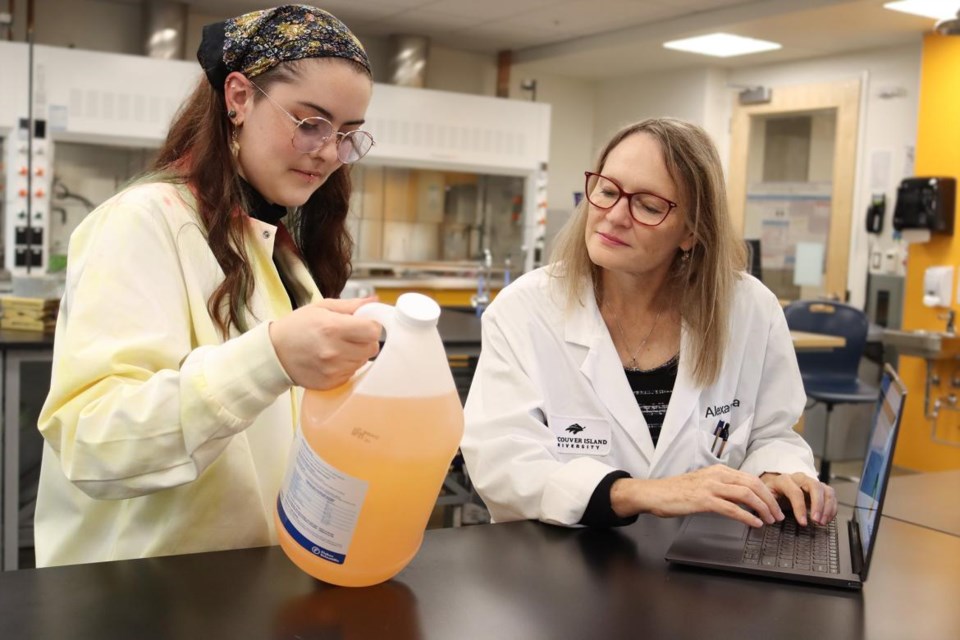A new solution is surfacing for boaters keen to tackle the problem of toxic chemicals in cleaning products that can poison salmon and other important marine life.
geared to help people choose the most eco-friendly products and cleaning methods while maintaining their vessels has been created by chemistry researchers at Vancouver Island University (VIU) and the Pacific Salmon Foundation (PSF).
Feedback from commercial fishers and recreational boaters resources has been really positive said, according to VIU professor Alexandra Weissfloch and student researcher Lily Eggert.
Most boat owners see the value of protecting the aquatic ecosystems in the oceans and lakes which they rely on for their livelihood and enjoyment, they said.
“People love being out on the water, and I think that they will happily choose [to use] something that is less harmful,” Weissfloch said.
Chemical cleaners are a dirty problem
Many boat cleaners contain toxic chemicals that once they find their way into water can kill or harm a wide range of aquatic life from microscopic algae to killer whales, Weissfloch said.
Contaminants can also ripple upwards, or bioaccumulate, when poisoned microorganisms and small fish are eaten by larger prey like salmon, birds or mammals that may suffer reproductive issues and population declines.
Transparency around toxic products is needed
It’s difficult for boaters to find out what is in their cleaning products, said Weissfloch, noting there are no government requirements obliging companies to list the chemical ingredients on their packaging the way food items must.
“In my opinion, that is absolutely something that should change,” she said.
However, even if chemical ingredients are listed, it can still leave consumers in the dark about their potential impacts to the environment, she added.
Companies sometimes provide a safety data sheet for a product, which outlines things like potential hazards, safe disposal and use guidelines, the environmental toxicity, or first aid information. But it’s not mandatory, Weissfloch said.
Other producers provide safety information on their website, if consumers can be bothered to take that extra step.
“Sometimes it’s there and easy to find. Other times you have to really, really dig,” she said.
A simple fix would be to require companies to provide a QR code that consumers can scan with their cell phones to easily obtain the chemical ingredients, environmental risks, or safety hazards, she added — but even then, many people still might not know which individual chemicals to avoid, especially in combination with others on the list.
A searchable solution
That’s where the dashboard with its searchable database and fact sheet developed by VIU and Pacific Salmon Foundation comes in handy, Weissfloch said.
They’re easy to use and understand, and take the guesswork out of the process of choosing eco-friendly products, or at least some less harmful ones.
The dashboard uses a “stoplight” system to rate a product's level of concern — green for less concern, red for more, while products marked in gray indicate researchers found little or no information to allow them to make a determination.
Boaters can also search the catalogue by the type of cleaning product needed, like algae scrubs, wax coats or polishes, or fibreglass or bilge cleaners. The Pacific Salmon Foundation fact sheet also provides a ready-made list of some good product choices and explainers about chemical water pollutants.
Boaters can clean up their act
The best way to limit harms from potentially damaging chemicals is to avoid using them at all, the handout notes.
Hull scraping and elbow grease, in combination with homemade safe and cheap cleaning solutions using things like vinegar or baking soda and a power washing can take care of most jobs like removing rust, grime or the organic matter that grows on the bottom of boats.
If boaters want to use soaps and detergents they should wash their boats on land at marinas with waste or grey-water facilities that collect runoff and funnel it to municipal treatment plants or, at minimum, septic systems.
“A lot of what we are doing here is preventative, to make sure these chemicals that can cause these downstream issues aren’t ending up in the water bodies to begin with,” stressed Eggert.
Consumers should also be wary of “greenwashing” by companies with vague or weak claims about the environmental friendliness of their boat-cleaning products, Weissfloch added.
If people have to make a snap judgment in the aisle while looking for less toxic boat cleaning products, they should look for certified eco-labels subject to stringent criteria to ensure ingredients don’t pose risks to human health or the environment. The , backed by the U.S. Environmental Protection Agency, or , certified by a private company that evaluates a product’s environmental life cycle are reputable options, the project team suggests.
The idea behind the initiative is to provide consumers with easier ways to make “green” choices if they can, Weissfloch said.
“We’re not telling people to absolutely not use brands that have chemicals of concern in them, but that they need to be aware and minimize the use of them.”



